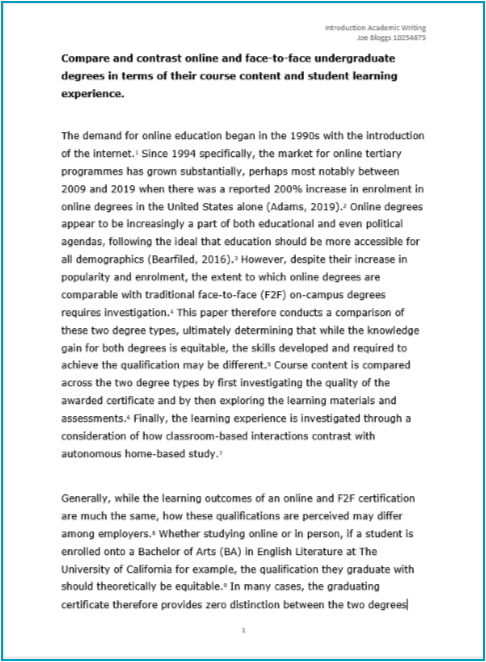Are university formatting guidelines important?

This is the first of two chapters about Essay Formatting. To complete this reader, read each chapter carefully and then unlock and complete our materials to check your understanding.
– Introduce the concept of essay formatting at university
– Compare formatted and unformatted work
– Explore the importance of formatting consistently when attempting to achieve high grades in academic work
Chapter 1
There are lots of rules that students should follow if they wish to succeed in a bachelor’s or master’s degree. From rules of academic conduct such as plagiarism and collusion avoidance to rules of which referencing style to use when conducting academic research. One of the simplest rules that students often overlook however relates to the design elements of a piece of assessed work, such as font size and style or the margin widths. When considered together, these elements are known as formatting.

Although design-oriented rules of formatting might seem insignificant, these features can affect your final grade and so are worth paying attention to. In this short reader on essay formatting, we therefore offer assistance in Chapter 1 with understanding what formatting is and why universities are so strict about how academic assignments are displayed. Then, in Chapter 2, we explore the ten key essay-formatting features that students should check before submitting their essay. Complete these two chapters and our related Chapter Worksheets and you should hopefully feel much more confident about handing in a perfectly formatted essay.
Why are universities strict on formatting?
Formatting involves paying careful attention to aspects of the design and layout of a document. This may include the font type and font size, the spacing between lines of text, and which style of referencing is being used. Submit an essay that isn’t formatted correctly and you risk lowering your grade. This is because formatting is normally a small component of a tutor’s marking rubric, particularly in preliminary-year, pre-sessional, in-sessional and other EAP programmes.
Not only may poor formatting reduce your grade, but your tutor may also form a negative first impression of your submission. They may suspect that the content of your essay or presentation is reflected in the low quality of your layout and design. To see this in action, take a look at the two examples below. Which essay is consistently formatted, and which appears to be of higher standard?


In short, universities set formatting requirements so:
- submitted work looks neat and consistent
- students are consistent with each other
- tutors are not distracted by poor formatting when marking
- tutors can more easily gauge the length of a piece of writing
- students can demonstrate an ability to follow institutional rules

How can students know these requirements?
To find out the formatting requirements of your university, there are a number of places that you may wish to look. If these requirements are university wide, try looking through your student handbook for instance. More likely, however, is that your faculty or school may have a document that details the formatting and presentation guidelines for work submitted. Also common is when a particular module sets its own specific formatting guidelines, in which case students should turn to their module handbook or ask their tutor in person.
When should I format my essay?
Any submission that has formatting requirements should be checked thoroughly during the proofreading stage of the writing process to make sure that the correct rules have been followed. What this generally means is that students should check these design-oriented features a day or two before submission – the same time that they check for typos, spelling errors and grammar mistakes. However, a good student should probably follow formatting guidelines from the very start of a course or module, using these guidelines in every document they create regardless of whether that document is going to be submitted. This creates consistency.
Which formatting features are most common?
Included below are the ten key formatting features that most academic institutions will expect you to modify. For more information about each of these ten features, continue studying with Chapter 2 of this short reader.


To reference this reader:
Academic Marker (2022) Essay Formatting. Available at: https://academicmarker.com/essay-writing/essay-formatting/ (Accessed: Date Month Year).
Downloadables
Once you’ve completed both chapters in this short reader about Essay Formatting, you might then wish to download our Chapter Worksheets to check your progress or print for your students. These professional PDF worksheets can be easily accessed for only a few Academic Marks.
Chapter 1 explores the topic: Are university formatting guidelines important? Our Chapter 1 Worksheet (containing guidance, activities and answer keys) can be accessed here at the click of a button.
Chapter 2 explores the topic: Which 10 essay formatting features should I check? Our Chapter 2 Worksheet (containing guidance, activities and answer keys) can be accessed here at the click of a button.
To save yourself 1 Marks, click on the button below to gain unlimited access to all of our Essay Formatting Chapter Worksheets. This All-in-1 Pack includes every chapter, activity and answer key related to this topic in one handy and professional PDF.
Collect Academic Marks
-
100 Marks for joining
-
25 Marks for daily e-learning
-
100-200 for feedback/testimonials
-
100-500 for referring your colleages/friends